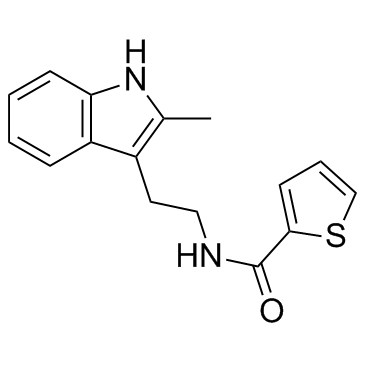CK-636

CK-636 structure
|
Common Name | CK-636 | ||
|---|---|---|---|---|
| CAS Number | 442632-72-6 | Molecular Weight | 284.376 | |
| Density | 1.3±0.1 g/cm3 | Boiling Point | 576.8±45.0 °C at 760 mmHg | |
| Molecular Formula | C16H16N2OS | Melting Point | N/A | |
| MSDS | Chinese USA | Flash Point | 302.6±28.7 °C | |
| Symbol |

GHS07 |
Signal Word | Warning | |
Use of CK-636CK-636 is a cell permeable inhibitor of Arp2/3 complex, that could inhibit actin polymerization, with IC50 values of 4 μM, 24 μM and 32 μM for human, fission yeast and bovine, respectively. |
| Name | ck-636 |
|---|---|
| Synonym | More Synonyms |
| Description | CK-636 is a cell permeable inhibitor of Arp2/3 complex, that could inhibit actin polymerization, with IC50 values of 4 μM, 24 μM and 32 μM for human, fission yeast and bovine, respectively. |
|---|---|
| Related Catalog | |
| Target |
IC50: 4/24/32 uM (Human/fission yeast/bovine Arp2/3)[1]. |
| In Vitro | CK-636 binds between Arp2 and Arp3, where it appears to block movement of Arp2 and Arp3 into their active conformation. CK-636 inserts into the hydrophobic core of Arp3 and alters its conformation. CK-636 prevents actin polymerization and the formation of actin filament comet tails by Listeria in infected SKOV3 cells (IC50=22 µM)[1]. Additionally, CK-636-treated T cells exhibits elongated morphology with sharp pseudopodia at the leading edges, while the breadth of the CK-636-treated T cells is about 30% less than that of DMSO-treated T cells[2]. |
| References |
| Density | 1.3±0.1 g/cm3 |
|---|---|
| Boiling Point | 576.8±45.0 °C at 760 mmHg |
| Molecular Formula | C16H16N2OS |
| Molecular Weight | 284.376 |
| Flash Point | 302.6±28.7 °C |
| Exact Mass | 284.098328 |
| PSA | 73.13000 |
| LogP | 3.10 |
| Appearance of Characters | peach to light tan |
| Vapour Pressure | 0.0±1.6 mmHg at 25°C |
| Index of Refraction | 1.674 |
| Storage condition | 2-8°C |
| Water Solubility | DMSO: ≥20mg/mL |
|
Discovery of the migrasome, an organelle mediating release of cytoplasmic contents during cell migration.
Cell Res. 25(1) , 24-38, (2015) Cells communicate with each other through secreting and releasing proteins and vesicles. Many cells can migrate. In this study, we report the discovery of migracytosis, a cell migration-dependent mech... |
| N-[2-(2-Methyl-1H-indol-3-yl)ethyl]-2-thiophenecarboxamide |
| 2-Thiophenecarboxamide, N-[2-(2-methyl-1H-indol-3-yl)ethyl]- |